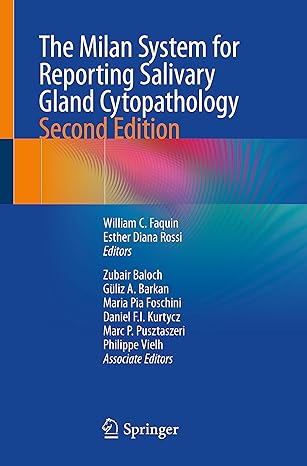1 The Milan System for Reporting Salivary Gland Cytopathology
2 Non-Diagnostic
3 Non-Neoplastic
4 Atypia of Undetermined Significance (AUS)
5 Neoplasm
6 Suspicious for Malignancy
7 Malignant
8 Ancillary Studies for Salivary Gland Cytology
9 Imaging of the Salivary Glands
10 Clinical Management
11 Histologic Considerations and Salivary Gland Tumor Classification in Surgical Pathology
The Second Edition of The Milan System for Reporting Salivary Gland Cytopathology, like the First Edition,
represents a collaborative effort by a multidisciplinary group of cytopathologists, surgical pathologists,
molecular pathologists, radiologists, and head and neck surgeons. This international group shares the goal
of creating a practical and uniform reporting system for salivary gland fine needle aspiration (FNA). This
book is organized into six general diagnostic categories: “Non-Diagnostic,” “Non-Neoplastic,” “Atypia
of Undetermined Significance (AUS),” “Neoplasm: Benign,” “Neoplasm: Salivary Gland Neoplasm of Uncertain
Malignant Potential (SUMP),” “Suspicious for Malignancy,” and “Malignant.” It includes definitions,
morphologic criteria, and explanations for each of the diagnostic categories. Specific chapters are
dedicated to the application of the latest available ancillary studies, radiologic features of salivary
gland lesions, clinical management, and histological considerations including updates from the most recent
5th Edition WHO blue book.
The Milan System for Reporting Salivary Gland Cytopathology 2nd Edition represents an essential step towards
increasing the overall effectiveness of salivary gland FNA and fostering better communication between
clinicians and between institutions to improve overall patient care.


